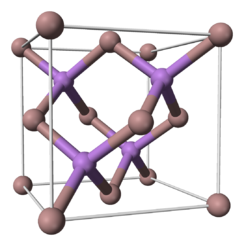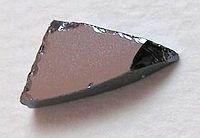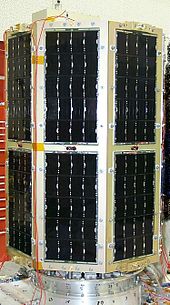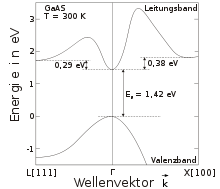- Gallium arsenide
-
Gallium arsenide 
 Gallium arsenide
Gallium arsenideIdentifiers CAS number 1303-00-0 
PubChem 14770 ChemSpider 14087 
EC number 215-114-8 UN number 1557 MeSH gallium+arsenide RTECS number LW8800000 Jmol-3D images Image 1 - [Ga-]$[As+]
Properties Molecular formula GaAs Molar mass 144.645 g mol−1 Exact mass 143.847177329 g mol−1 Appearance Very dark red, vitreous crystals Density 5.316 g cm−3 [1] Melting point 1238 °C, 1511 K, 2260 °F
Solubility in water insoluble Band gap 1.424 eV (at 300 K) Electron mobility 8500 cm2/(V·s) (at 300 K) Thermal conductivity 0.55 W/(cm·K) (at 300 K) Refractive index (nD) 3.8[2] Structure Crystal structure Zinc blende Space group T2d-F-43m Lattice constant a = 565.35 pm Coordination
geometryTetrahedral Molecular shape Linear Hazards MSDS External MSDS GHS pictograms 

GHS hazard statements H301, H331, H410 GHS precautionary statements P261, P273, P301+310, P311, P501 EU classification  T
T  N
NR-phrases R23/25, R50/53 S-phrases (S1/2), S20/21, S28, S45, S60, S61 NFPA 704  arsenide (verify) (what is:
arsenide (verify) (what is:  /
/ ?)
?)
Except where noted otherwise, data are given for materials in their standard state (at 25 °C, 100 kPa)Infobox references Gallium arsenide (GaAs) is a compound of the elements gallium and arsenic. It is a III/V semiconductor, and is used in the manufacture of devices such as microwave frequency integrated circuits, monolithic microwave integrated circuits, infrared light-emitting diodes, laser diodes, solar cells and optical windows.
Contents
Preparation and chemistry
In the compound, gallium has a +3 oxidation state. Gallium arsenide can be prepared by direct reaction from the elements which is used in a number of industrial processes:[3]
- Crystal growth using a horizontal zone furnace in the Bridgman-Stockbarger technique, in which gallium and arsenic vapors react and free molecules deposit on a seed crystal at the cooler end of the furnace.
- Liquid encapsulated Czochralski (LEC) growth is used for producing high purity single crystals that exhibit semi-insulating characteristics.
Alternative methods for producing films of GaAs include:[3][4]
- VPE reaction of gaseous gallium metal and arsenic trichloride:
- 2 Ga + 2 AsCl3 → 2 GaAs + 3 Cl2
- MOCVD reaction of trimethylgallium and arsine:
- Ga(CH3)3 + AsH3 → GaAs + 3 CH4
- Molecular beam epitaxy (MBE) of gallium and arsenic:
- 4 Ga + As4 → 4 GaAs
or
- 2 Ga + As2 → 2 GaAs
Wet etching of GaAs industrially uses an oxidizing agent, for example hydrogen peroxide or bromine water,[5] and the same strategy has been described in a patent relating to processing scrap components containing GaAs where the Ga3+ is complexed with a hydroxamic acid ("HA"), for example:[6]:
- GaAs + H2O2 + "HA" → "GaA" complex + H3AsO4 + 4 H2O
Oxidation of GaAs occurs in air and degrades performance of the semiconductor. The surface can be passivated by depositing a cubic gallium(II) sulfide layer using a tert-butyl gallium sulfide compound such as (tBuGaS)7.[7]
Comparison with silicon
GaAs advantages
GaAs has some electronic properties which are superior to those of silicon. It has a higher saturated electron velocity and higher electron mobility, allowing transistors made from it to function at frequencies in excess of 250 GHz. Unlike silicon junctions, GaAs devices are relatively insensitive to heat owing to their wider bandgap. Also, GaAs devices tend to have less noise than silicon devices especially at high frequencies which is a result of higher carrier mobilities and lower resistive device parasitics. These properties recommend GaAs circuitry in mobile phones, satellite communications, microwave point-to-point links and higher frequency radar systems. It is used in the manufacture of Gunn diodes for generation of microwaves.
Another advantage of GaAs is that it has a direct band gap, which means that it can be used to emit light efficiently. Silicon has an indirect bandgap and so is very poor at emitting light. Nonetheless, recent advances may make silicon LEDs and lasers possible.
As a wide direct band gap material and resulting resistance to radiation damage, GaAs is an excellent material for space electronics and optical windows in high power applications.
Because of its wide bandgap, pure GaAs is highly resistive. Combined with the high dielectric constant, this property makes GaAs a very good electrical substrate and unlike Si provides natural isolation between devices and circuits. This has made it an ideal material for microwave and millimeter wave integrated circuits, MMICs, where active and essential passive components can readily be produced on a single slice of GaAs.
One of the first GaAs microprocessors was developed in the early 1980s by the RCA corporation and was considered for the Star Wars program of the United States Department of Defense. Those processors were several times faster and several orders of magnitude more radiation hard than silicon counterparts, but they were rather expensive.[8] Other GaAs processors were implemented by the supercomputer vendors Cray Computer Corporation, Convex, and Alliant in an attempt to stay ahead of the ever-improving CMOS microprocessor. Cray eventually built one GaAs-based machine in the early 1990s, the Cray-3, but the effort was not adequately capitalized, and the company filed for bankruptcy in 1995.
Complex layered structures of gallium arsenide in combination with aluminium arsenide (AlAs) or the alloy AlxGa1-xAs can be grown using molecular beam epitaxy (MBE) or using metalorganic vapor phase epitaxy (MOVPE). Because GaAs and AlAs have almost the same lattice constant, the layers have very little induced strain, which allows them to be grown almost arbitrarily thick. This allows for extremely high performance high electron mobility, HEMT transistors and other quantum well devices.
Silicon advantages
Silicon has three major advantages over GaAs for integrated circuit manufacture. First, silicon is abundant and cheap to process. Si is highly abundant in the Earth's crust, in the form of silicate minerals. The economy of scale available to the silicon industry has also reduced the adoption of GaAs.
In addition, a Si crystal has an extremely stable structure mechanically and it can be grown to very large diameter boules and can be processed with very high yields. It is also a decent thermal conductor thus enable very dense packing of transistors, all very desirable for design and manufacturing of very large ICs. Such good mechanical characteristics also makes it a suitable material for the rapidly developing field of nanoelectronics.
The second major advantage of Si is the existence of a native oxide (silicon dioxide), which is used as an insulator in electronic devices. Silicon dioxide can easily be incorporated onto silicon circuits, and such layers are adherent to the underlying Si. GaAs does not have a native oxide and does not easily support a stable adherent insulating layer.
The third, and perhaps most important, advantage of silicon is that it possesses a much higher hole mobility. This high mobility allows the fabrication of higher-speed P-channel field effect transistors, which are required for CMOS logic. Because they lack a fast CMOS structure, GaAs logic circuits have much higher power consumption, which has made them unable to compete with silicon logic circuits.
Silicon has relatively low absorptivity for the sunlight meaning about 100 micrometers of Si is needed to absorb most sunlight. Such a layer is relatively robust and easy to handle. In contrast, the absorptivity of GaAs is so high that a corresponding layer would be only a few micrometers thick and mechanically unstable.[9]
Silicon is a pure element, avoiding the problems of stoichiometric imbalance and thermal unmixing of GaAs.
Silicon has a nearly perfect lattice, impurity density is very low and allows to build very small structures (currently down to 25 nm). GaAs in contrast has a very high impurity density, which makes it difficult to build ICs with small structures, so the 500 nm process is a common process for GaAs.
 High-efficiency, triple-junction gallium arsenide solar cells covering the MidSTAR-1 satellite
High-efficiency, triple-junction gallium arsenide solar cells covering the MidSTAR-1 satellite
Other applications
Solar cells and detectors
Another important application of GaAs is for high efficiency solar cells. Gallium arsenide (GaAs) is also known as single-crystalline thin film and are high cost high efficiency solar cells.
In 1970, the first GaAs heterostructure solar cells were created by the team led by Zhores Alferov in the USSR.[10][11][12] In the early 1980s, the efficiency of the best GaAs solar cells surpassed that of silicon solar cells, and in the 1990s GaAs solar cells took over from silicon as the cell type most commonly used for Photovoltaic arrays for satellite applications. Later, dual- and triple-junction solar cells based on GaAs with germanium and indium gallium phosphide layers were developed as the basis of a triple junction solar cell which held a record efficiency of over 32% and can operate also with light as concentrated as 2,000 suns. This kind of solar cell powers the rovers Spirit and Opportunity, which are exploring Mars' surface. Also many solar cars utilize GaAs in solar arrays.
Complex designs of AlxGa1-xAs-GaAs devices can be sensitive to infrared radiation (QWIP).
GaAs diodes can be used for the detection of X-rays.[13]
Light emission devices
GaAs has been used to produce (near-infrared) laser diodes since 1962.[14]
Single crystals of gallium arsenide can be manufactured by the Bridgeman technique, as the Czochralski process is difficult for this material due to its mechanical properties. However, an encapsulated Czochralski method is used to produce ultra-high purity GaAs for semi-insulators.
GaAs is often used as a substrate material for the epitaxial growth of other III-V semiconductors including: InGaAs and GaInNAs.
Safety
The toxicological properties of gallium arsenide have not been thoroughly investigated. On one hand, due to its arsenic content, it is considered highly toxic and carcinogenic. On the other hand, the crystal is stable enough that ingested pieces may be passed with negligible absorption by the body. When ground into very fine particles, such as in wafer-polishing processes, the high surface area enables more reaction with water releasing some arsine and/or dissolved arsenic. The environment, health and safety aspects of gallium arsenide sources (such as trimethylgallium and arsine) and industrial hygiene monitoring studies of metalorganic precursors have been reported.[15] California lists gallium arsenide as a carcinogen.[16]
See also
- Aluminium arsenide
- Aluminium gallium arsenide
- Arsine
- Cadmium telluride
- Gallium antimonide
- Gallium arsenide phosphide
- Gallium manganese arsenide
- Gallium phosphide
- Gallium nitride
- Heterostructure emitter bipolar transistor
- Indium arsenide
- Indium gallium arsenide
- Indium phosphide
- Light-emitting diode
- MOVPE
- Multijunction
- Photomixing
- Trimethylgallium
References
- ^ P. Patnaik (2003). Handbook of Inorganic Chemicals. McGraw-Hill. p. 310. ISBN 0070494398. http://books.google.com/books?id=Xqj-TTzkvTEC&pg=PA310.
- ^ Refractive index of GaAs. Ioffe database
- ^ a b S. J. Moss, A. Ledwith (1987). The Chemistry of the Semiconductor Industry. Springer. ISBN 0216920051.
- ^ Lesley Smart, Elaine A. Moore (2005). Solid State Chemistry: An Introduction. CRC Press. ISBN 0748775161.
- ^ M. R. Brozel, G. E. Stillman (1996). Properties of Gallium Arsenide. IEEE Inspec. ISBN 085296885X.
- ^ "Oxidative dissolution of gallium arsenide and separation of gallium from arsenic" J. P. Coleman and B. F. Monzyk U.S. Patent 4,759,917 (1988)
- ^ "Chemical vapor deposition from single organometallic precursors" A. R. Barron, M. B. Power, A. N. MacInnes, A. F.Hepp, P. P. Jenkins U.S. Patent 5,300,320 (1994)
- ^ Von Jurij Šilc, Borut Robič, Theo Ungerer (1999). Processor architecture: from dataflow to superscalar and beyond. Springer. p. 34. ISBN 3540647988.
- ^ Single-Crystalline Thin Film – GaAs
- ^ Alferov, Zh. I., V. M. Andreev, M. B. Kagan, I. I. Protasov and V. G. Trofim, 1970, ‘‘Solar-energy converters based on p-n AlxGa1-xAs-GaAs heterojunctions,’’ Fiz. Tekh. Poluprovodn. 4, 2378 (Sov. Phys. Semicond. 4, 2047 (1971))
- ^ Nanotechnology in energy applications, pdf, p.24
- ^ Nobel Lecture by Zhores Alferov, pdf, p.6
- ^ Glasgow University report on CERN detector
- ^ Hall, Robert N.; G. E. Fenner, J. D. Kingsley, T. J. Soltys, and R. O. Carlson (November 1962). "Coherent Light Emission From GaAs Junctions". Physical Review Letters 9 (9): 366–369. Bibcode 1962PhRvL...9..366H. doi:10.1103/PhysRevLett.9.366.
- ^ D V Shenai-Khatkhate, R Goyette, R L DiCarlo and G Dripps (2004). "Environment, health and safety issues for sources used in MOVPE growth of compound semiconductors". Journal of Crystal Growth 1–4: 816–821. Bibcode 2004JCrGr.272..816S. doi:10.1016/j.jcrysgro.2004.09.007.
- ^ "Chemicals Listed Effective August 1, 2008 as Known to the State of California to Cause Cancer or Reproductive Toxicity: gallium arsenide, hexafluoroacetone, nitrous oxide and vinyl cyclohexene dioxide". OEHHA. 2008-08-01. http://www.oehha.ca.gov/prop65/prop65_list/080108list.html.
External links
- Single-Crystalline Thin Film (EERE).
- Case Studies in Environmental Medicine: Arsenic Toxicity
- Physical properties of gallium arsenide (Ioffe Institute)
- Facts and figures on processing gallium arsenide
Gallium compounds Categories:- Arsenides
- Compound semiconductors
- Inorganic compounds
- Gallium compounds
- IARC Group 1 carcinogens
- Optoelectronics
- Semiconductor materials
- III-V compounds
- Solar cells
- Light-emitting diode materials
Wikimedia Foundation. 2010.


